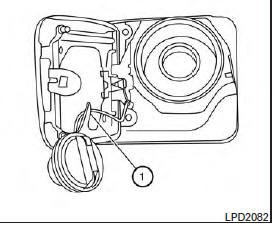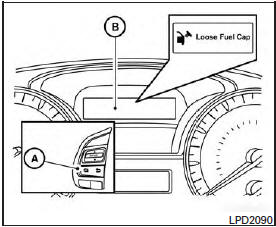Nissan Altima (L33) 2013-2018 Owners Manual: Fuel-filler cap
WARNING
● Gasoline is extremely flammable and
highly explosive under certain conditions.
You could be burned or seriously injured if it is misused or mishandled.
Always stop the engine and do not smoke or allow open flames or sparks near the vehicle when refueling.
● Do not attempt to top off the fuel tank after the fuel pump nozzle shuts off automatically. Continued refueling may cause fuel overflow, resulting in fuel spray and possibly a fire.
● Use only an original equipment type
fuel-filler cap as a replacement. It has a
built-in safety valve needed for proper
operation of the fuel system and emission
control system. An incorrect cap
can result in a serious malfunction and
possible injury. It could also cause
the  Malfunction Indicator Light
Malfunction Indicator Light
(MIL) to come on.
● Never pour fuel into the throttle body to attempt to start your vehicle.
● Do not fill a portable fuel container in
the vehicle or trailer. Static electricity
can cause an explosion of flammable
liquid, vapor or gas in any vehicle or
trailer. To reduce the risk of serious
injury or death when filling portable fuel
containers:
– Always place the container on the
ground when filling.
– Do not use electronic devices when filling.
– Keep the pump nozzle in contact with the container while you are filling it.
– Use only approved portable fuel containers for flammable liquid.
CAUTION
● Do not use E-15 or E-85 fuel in your vehicle. For further information see the “Fuel Recommendation” in the “Technical and consumer information” section of this manual.
● The LOOSE FUEL CAP warning will appear
if the fuel-filler cap is not properly
tightened. It may take a few driving trips
for the message to be displayed. Failure
to tighten the fuel-filler cap properly
after the LOOSE FUEL CAP warning appears
may cause the  Malfunction
Malfunction
Indicator Light (MIL) to illuminate.
● Failure to tighten the fuel-filler cap
properly may cause the  Malfunction
Malfunction
Indicator Light (MIL) to illuminate.
If the  light illuminates because
light illuminates because
the fuel-filler cap is loose or missing,
tighten or install the cap and continue
to drive the vehicle. The  light
light
should turn off after a few driving trips.
If the  light does not turn off
light does not turn off
after a
few driving trips, have the vehicle inspected
by a NISSAN dealer.
● For additional information, see the “Malfunction Indicator Light (MIL)” in the “Instruments and Controls” section in this manual.
● If fuel is spilled on the vehicle body, flush it away with water to avoid paint damage.

To remove the fuel-filler cap: 1. Turn the fuel-filler cap counterclockwise to remove.
2. Put the fuel-filler cap on the cap holder 1 while refueling.
To install the fuel-filler cap: 1. Insert the fuel-filler cap straight into the fuelfiller tube.
2. Turn the fuel-filler cap clockwise until a single click is heard.

Loose Fuel Cap warning The LOOSE FUEL CAP warning appears in the vehicle information display when the fuel-filler cap is not tightened correctly after the vehicle has been refueled. It may take a few driving trips for the message to be displayed. To turn off the warning, perform the following: 1. Remove and install the fuel-filler cap as soon as possible. See “Fuel-filler cap” in this section.
2. Tighten the fuel-filler cap until it clicks.
3. Press the next  button A on the
button A on the
steering
wheel for about 1 second to turn off the
LOOSE FUEL CAP warning B after tightening
the fuel-filler cap.

 Opener operation
Opener operation Tilt/telescopic steering
Tilt/telescopic steering